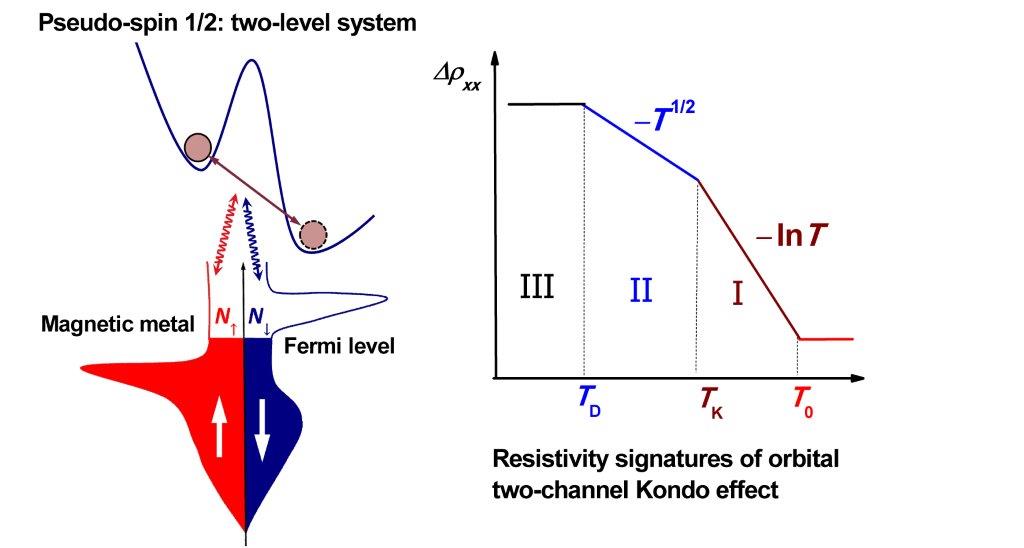Kondo effect is a strongly correlated physics arising from the conduction electrons of a metal screening localized magnetic impurities. When two spin-degenerate free electrons attempting to screen one spin-1/2 magnetic impurity, a new ground state called two-channel Kondo effect occurs. The overscreened two-channel Kondo (2CK) effect displaying exotic non-Fermi-liquid (NFL) physics has attracted widespread interest in recent years, especially due to their potential relevance to a host of current topics including strongly correlated physics, Majorana fermions, high-Tc superconductors, topological matters, carbon-nanotubes, and quantum dots.
However, the strict requirements of zero local magnetic field and channel symmetry make a direct observation of the spin 2CK effect difficult. Intriguingly, theories expect an analogous orbital 2CK effect which is physically equal with spin 2CK but arises from the resonant scattering of conduction electrons from two spin channels at the pseudo-spin impurity of two-level systems (TLSs) (see the figure below). The electrical transport studies could provide direct experimental evidence for the orbital 2CK effect: three-regime electrical resistivity upturn; strong magnetic field-independence; disorder nature of the TLSs. Despite the intensive studies for almost 30 years, the experimental proof for the existence of the orbital 2CK effect has been far from certain.
Recently, Prof. ZHAO Jianhua’s research team from Institute of Semiconductors, Chinese Academy of Sciences, in collaboration with Dr. ZHU Lijun from Martin-Luther University Halle (Germany), Prof. XIONG Peng and Prof. SCHLOTTMAN Pedro from Florida State University (USA), for the first time observed all the three electrical transport evidence of orbital 2CK effect in L10-MnAl epitaxial film.
Notably, taking advantage of the advanced molecular-beam epitaxy technique, they realized the effective tailoring of the Kondo temperature, coupling strength, energy splitting of the pseudo-spin, and density of the TLSs by accurately control the structural disorder degree, which strongly supports the theoretical model of orbital 2CK effect.
On the other hand, this is also the first time that the 2CK effect is observed in a material system with long-range ferromagnetic ordering, revealing that the orbital 2CK can stably coexist with spin polarized conduction bands.
This work was partly supported by MOST of China and NSFC.
The main findings of this work have been published online in Nature Communications on Feb. 24th, 2016. Details can be found at http://www.nature.com/ncomms/2016/160224/ncomms10817/full/ncomms10817.html

Figure 1. Schematic of orbital 2CK effect and its three–regime resistivity upturn. (Image by Prof. ZHAO Jianhua et al.)
Contact:
Prof. ZHAO Jianhua
E-mail: jhzhao@semi.ac.cn
Institute of Semiconductors, CAS (http://english.semi.cas.cn/)
